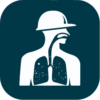
November is Lung Cancer Awareness Month. Every year, campaigners spend the month raising awareness of the disease and ways to protect against it.
Most attention is rightfully paid to smoking, which is indisputably the leading cause. But it’s not the only risk factor. Exposure to certain occupational hazards is also strongly linked to lung cancer cases.
In support of Lung Cancer Awareness Month 2024, we’re examining two of the biggest cancer risks workers are routinely exposed to: asbestos and silica.
Key Takeaways
- November is Lung Cancer Awareness Month, which highlights lung cancer risk factors and prevention strategies
- Asbestos and silica dust are two significant occupational hazards linked to lung cancer, especially in the construction industry.
- Awareness and compliance with legislation like the Control of Asbestos Regulations and Control of Substances Hazardous to Health Regulations are essential to protect workers from harmful exposures.
Lung Cancer Awareness Month
Lung Cancer Awareness Month started as Lung Cancer Awareness Day in 1995. Over the past 30 years, the event has grown, gathering endorsements from charities, non-profits and governments. Now, every November is officially recognised as Lung Cancer Awareness Month.
No two years are the same. Because so many organisations support the campaign, there’s no centralised theme. Instead, separate advocacy groups highlight their chosen aspect of the disease, with prevention as a common thread throughout the event.
For Lung Cancer Awareness Month 2024, we’re highlighting occupational hazards linked to the disease and what employers must do to protect their workers.
Lung Cancer Explained
Cancer is the rapid growth of abnormal cells, which develop into tumours if the process isn’t stopped. When this happens in the lungs, it’s called lung cancer.
There are two types of lung cancer: primary and secondary.
- Primary lung cancer starts in the lungs
- Secondary lung cancer starts elsewhere in the body before spreading to the lungs
There are two subtypes of primary lung cancer:
- Small cell lung cancer (SCLC)
- Non-small cell lung cancer (NSCLC)
Non-small cell lung cancer is the most common form of the disease, accounting for 90% of cases in the UK. It’s less aggressive than the small cell variant, so it takes longer for symptoms to reveal themselves.
Unequal growth rates also mean the two subtypes are treated differently. NSCLC spreads relatively slowly, so it can often be treated with surgery. However, SCLC grows rapidly, so it quickly passes the point where surgery can be effective. Instead, it’s typically treated with chemotherapy drugs, which can suppress cancerous cells.
Lung Cancer Symptoms
Despite the different growth rates and treatments, both forms of lung cancer share common symptoms. These are:
- Persistent coughing (if a cough lasts for three weeks or more)
- Persistent hoarse voice (lasting three weeks or more)
- A change in a long-term cough, such as a different tone or feeling in your chest
- Coughing up blood
- Drawn-out or repeated chest infections
- Becoming short of breath or wheezy for no reason
- Feeling tired
- Losing weight without an explanation
- Persistent chest or shoulder pain without an explanation
Speak to your GP as soon as possible if you’re showing one or more of these symptoms.
Lung Cancer Causes
Lung cancer has no single cause, but several risk factors increase the likelihood of its development.
Smoking is by far the biggest one of these risk factors. It’s estimated that 60% of lung cancer cases are caused by smoking, which is why it gets the most attention during Lung Cancer Awareness Month.
If you do smoke, quitting is the single best thing you could do to protect yourself against lung cancer. But smoking isn’t the only risk factor.
Primary lung cancer is also closely linked to occupational hazards such as dust and asbestos. When these substances are inhaled, particles become embedded in the lung tissue. These particles can trigger cancerous cells to grow or cause other conditions that increase the risk of cancerous cell growth.
Because of these risks, exposure to dust and asbestos at work is highly regulated.

Occupational Risk Factors
Below, we’ve covered asbestos and silica dust, the two biggest occupational risk factors. But these aren’t the only hazardous substances linked to lung cancer. Multiple different dusts, fumes and vapours found in workplaces also increase lung cancer risks.
The Health and Safety Executive (HSE) offers more guidance on managing lung disease risks at work here.
Asbestos
Asbestos causes approximately 5,000 lung cancer cases each year. Around half of these are typical lung cancer. The rest are cases of mesothelioma, a cancer that affects the lining of the lungs and is almost always the result of asbestos exposure.
The most at-risk group is the over 65s who worked with asbestos before its outright ban in 1999, but new exposures still happen today. An estimated 1.5 million buildings in the UK contain asbestos.
If it’s in good condition, asbestos is relatively safe. But it’s extremely hazardous when it’s disturbed or damaged, which means workers are at risk if they drill, cut or remove materials containing asbestos without proper protection.
Anyone who owns or manages a building that contains asbestos (or is suspected to contain asbestos) has a duty to manage it under the Control of Asbestos Regulations 2012 (CAR).
CAR also requires employers to protect their workers at risk of exposure. They must be trained to recognise asbestos hazards and take the necessary precautions to avoid disturbing it.

Silica Dust
Silica dust isn’t considered a threat the same way asbestos is. For one, silica-containing products are still widely used in the UK. Silica is found in:
- Concrete
- Cement
- Bricks
- Mortar
- Tiles
- Stone countertops
- Stone flooring
- Ceramic
- Porcelain
The link between silica exposure and lung cancer isn’t as clear, either. But silica dust exposure is known to cause chronic obstructive pulmonary disease (COPD), a significant lung cancer risk factor.
COPD describes several different conditions that narrow airways, cause chronic inflammation and make it harder to breathe. All of these effects make abnormal cell growth more likely to happen in the lungs. Research suggests that people with COPD are four to six times more likely to develop lung cancer, independent of other factors.
Workers who cut, grind, drill or process silica-containing materials must be protected from inhaling silica dust under the Control of Substances Hazardous to Health Regulations (COSHH).
Similar to asbestos, construction workers are at the greatest risk. But silica isn’t only used to build. Workers in agriculture and manufacturing are also regularly put at risk if they interact with silica-containing products.
You can read more about silica dust risks and how to manage them here.

Health and Safety Training for Lung Cancer Prevention
Lung Cancer Awareness Month is a time to highlight both causes and prevention. While smoking receives most of the attention, occupational hazards like asbestos and silica dust are also significant risk factors. Regulations like CAR and COSHH are in place to protect workers from these dangers, but awareness and proper training are vital in ensuring safety and compliance.
We offer online health and safety training for the construction industry, including courses on asbestos awareness and silica dust safety. These courses help employers comply with regulations and give workers the knowledge to protect themselves on the job.
About the author(s)

Jonathan Goby



























































































































































































































































































































































































































































































































































































































































